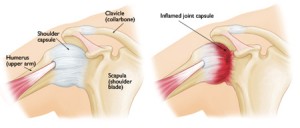Frozen shoulder is also known by the technical name adhesive capsulitis.
This means what it says—in times of trouble, a capsule that surrounds the shoulder joint will bind all of its parts together limiting the range of motion.
Within the shoulder capsule, there are several bursa in between bones to encourage mobility.
The tendon of the long head of the biceps brachii muscle also travels inside the capsule which is why pain in the biceps tendon is almost always present in cases of frozen shoulder.
The shoulder is a ball-and-socket joint made up of three bones: the arm bone (humerus) the shoulder blade (scapula) and the collarbone (clavicle), which make up the shoulder girdle.
I have written before how the shoulder joint is unique because it has muscle tendons working as ligaments.
The ligaments of the shoulder joint are lax by design to allow for a greater range of motion.
As opposed to the hip socket that is an actual cup, or socket, for the ball to fit in, the ball at the top of the arm bone fits into a much less finished or more shallow socket formed by bones of the shoulder girdle— the acromion and coracoid processes and the glenoid cavity (fossa) of the scapula which is a depression on the head of the scapula, between the acromion and coracoid processes.
The ball of the humerus sits in the glenoid cavity.
The shoulder capsule surrounds the shoulder joint and rotator cuff tendons and when someone moves into the frozen shoulder stage of an injury the capsule thickens and becomes tight.
Literal adhesions develop. This is going to affect the bursas within the joint as well as the bicep tendon that is also inside the capsule.
A frozen shoulder causes pain and stiffness in the shoulder. Over time, the shoulder becomes very hard to move.
The tissues around the joint harden, scar tissue forms and shoulder movements become limited and painful.
While anyone can get a frozen shoulder, most incidences occur in women. Oddly, it is thought that it will simply go away in many cases, though it can take up to a year to work through its stages (which I will cover next).
In my wife’s case, it took some rather intense physical therapy to solve the problem but who is to say that it wouldn’t have eventually cleared of its own accord?
***

